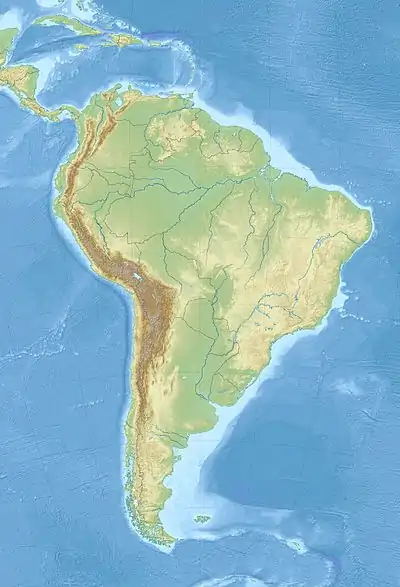Pebas Formation
The Pebas Formation is a lithostratigraphic unit of Miocene age, found in western Amazonia. The formation extends over 1,000,000 square kilometres (390,000 sq mi), including parts of Brazil, Peru, Ecuador and Colombia.[1] It is interpreted as representing the deposits of a lake ("Lake Pebas") or series of lakes, formed within the foreland basin of the Andes mountain belt. It is known for its abundant fossil ostracods and molluscs and an unusually diverse group of crocodylians.[2]
| Pebas Formation | |
|---|---|
| Stratigraphic range: Early Aquitanian-Tortonian (Colhuehuapian-Huayquerian) ~ | |
 The Pebas Mega-Wetland (or Lake Pebas), on the western side of this map, corresponds to the Pebas Formation | |
| Underlies | Marañón Formation |
| Overlies | Chambira Formation |
| Area | 1,000,000 km2 (390,000 sq mi) |
| Thickness | ~350–1,074 m (1,148–3,524 ft) |
| Lithology | |
| Primary | Siltstone, mudstone |
| Other | Coal/lignite |
| Location | |
| Coordinates | 7.4°S 75.0°W |
| Approximate paleocoordinates | 8.4°S 70.6°W |
| Region | Amazon Basin |
| Country | |
| Type section | |
| Named for | Pebas District |
Fossil content
| Group | Fossils | Notes |
|---|---|---|
| Mammals | Dinomyidae indet., ?Octodontoidea indet. | |
| Reptiles | Caiman wannlangstoni, Gnatusuchus pebasensis, Gryposuchus pachakamue, Purussaurus neivensis, Kuttanacaiman iquitosensis, Mourasuchus atopus, Paleosuchus sp., Podocnemis sp., Gavialoidea indet. | |
| Fishes | cf. Hydrolycus sp., Leporinus sp., Potamotrygon sp., Pristis sp., Anostomidae indet. | |
| Insects | Macroteleia yaguarum, Sycorax peruensis | |
Correlations
Laventan
| Formation | Honda | Honda | Aisol | Cura-Mallín | Pisco | Ipururo | Pebas | Capadare | Urumaco | Inés | Paraná | Map |
|---|---|---|---|---|---|---|---|---|---|---|---|---|
| Basin | VSM | Honda | San Rafael | Caldera | Pisco | Ucayali | Amazon | Falcón | Venezuela | Paraná |  Pebas Formation (South America) | |
| Country | ||||||||||||
| Boreostemma | ||||||||||||
| Hapalops | ||||||||||||
| Miocochilius | ||||||||||||
| Theosodon | ||||||||||||
| Xenastrapotherium | ||||||||||||
| Mylodontidae | ||||||||||||
| Sparassodonta | ||||||||||||
| Primates | ||||||||||||
| Rodents | ||||||||||||
| Birds | ||||||||||||
| Terror birds | ||||||||||||
| Reptiles | ||||||||||||
| megalodon | ||||||||||||
| Flora | ||||||||||||
| Insects | ||||||||||||
| Environments | Fluvial | Fluvio-deltaic | Fluvio-lacustrine | Fluvio-deltaic | Fluvial | |||||||
| Volcanic | Yes | |||||||||||
Huayquerian
| Formation | Cerro Azul | Ituzaingó | Paraná | Camacho | Raigón | Andalhuala | Chiquimil | Las Flores | Maimará | Palo | Pebas | Muyu | Rosa | Saldungaray | Salicas | Urumaco | Map |
|---|---|---|---|---|---|---|---|---|---|---|---|---|---|---|---|---|---|
| Basin | Colorado | Paraná | Hualfín | Tontal | Andes | Salta | Amazon | Huasi | Altiplano | BA | Velasco | Falcón |  Pebas Formation (South America) | ||||
| Country | |||||||||||||||||
| Cardiatherium | |||||||||||||||||
| Lagostomus | |||||||||||||||||
| Macroeuphractus | |||||||||||||||||
| Proeuphractus | |||||||||||||||||
| Pronothrotherium | |||||||||||||||||
| Pseudotypotherium | |||||||||||||||||
| Thylacosmilus | |||||||||||||||||
| Xotodon | |||||||||||||||||
| Macraucheniidae | |||||||||||||||||
| Primates | |||||||||||||||||
| Rodents | |||||||||||||||||
| Reptiles | |||||||||||||||||
| Birds | |||||||||||||||||
| Terror birds | |||||||||||||||||
| Flora | |||||||||||||||||
| Environments | Aeolian-fluvial | Fluvio-deltaic | Fluvial | Fluvio-lacustrine | Fluvial | Fluvio-lacustrine | Fluvio-deltaic | ||||||||||
| Volcanic | Yes | ||||||||||||||||
References
- Wesselingh et al., 2006
- Sala Gismondi et al., 2006
- CTA-45 at Fossilworks.org
- IQ114 at Fossilworks.org
- Amazonian amber at Fossilworks.org
Bibliography
- Montoya A., Diana M.; Diego Alonso O.; Alejandro Pinilla O., and José E. Arenas M. 2011. Geología de las Planchas 567, 568, 568bis, 569 and 569bis - 1:200,000, 1–187. Servicio Geológico Colombiano. Accessed 2018-06-01.
- Salas Gismondi, R.; J.J. Flynn; P. Baby; J.V. Tejada Lara; F.P. Wesselingh, and P-O. Antoine. 2015. A Miocene hyperdiverse crocodylian community reveals peculiar trophic dynamics in proto-Amazonian mega-wetlands. Proceedings of the Royal Society B: Biological Sciences 282. 20142490. Accessed 2018-05-20.
- Wesselingh, F.P.; M.C. Hoorn; J. Guerrero; M.E. Räsänen; L. Romero Pittmann, and J. Salo. 2006. The stratigraphy and regional structure of Miocene deposits in western Amazonia (Peru, Colombia and Brazil), with implications for late Neogene landscape evolution. Scripta Geologica 133. 291–322. Accessed 2017-08-15.
Further reading
- Antoine, P.; J.A. Abello; S. Adnet; A.J. Altamirano Sierra; P. Baby; G. Billet; M. Boivin; Y. Calderón, and A.R. Candela and J. Chabain, F. Corfu, D. A. Croft, M. Ganerød, C. Jaramillo, S. Klaus, L. Marivaux, R. E. Navarrete, M. J. Orliac, F. Parra, M. E. Pérez, F. Pujos, J. Rage, Anthony Ravel, Céline Robinet, Martin Roddaz, Julia Victoria Tejada Lara, Jorge Vélez-Juarbe, Frank P. Wesselingh and Rodolfo Salas Gismondi. 2016. A 60-million-year Cenozoic history of western Amazonian ecosystems in Contamana, eastern Peru. Gondwana Research 31. 30–59. Accessed 2020-03-19.
- Marcos C.Bissaro-Júnior, Leonardo Kerber, James L.Crowley, Ana M.Ribeiro, Renato P.Ghilardi, Edson Guilherme, Francisco R.Negri, Jonas P.Souza Filho, Annie S.Hsiou: "Detrital zircon U–Pb geochronology constrains the age of Brazilian Neogene deposits from Western Amazonia." Palaeogeography, Palaeoclimatology, Palaeoecology Volume 516, 15 February 2019, Pages 64–70 doi: 10.1016/j.palaeo.2018.11.032
This article is issued from Wikipedia. The text is licensed under Creative Commons - Attribution - Sharealike. Additional terms may apply for the media files.